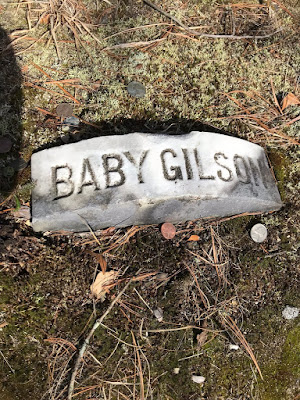One of the first things I read about Gilson Road Cemetery really intrigued me. According to an urban legend, a ghost will appear if you leave the cemetery and shout "Betty Gilson, I have your baby!" The ghost appears as a woman in Colonial-era clothing, and is sometimes seen in the middle of Gilson Road. At other other times she hides behind the trees that line the road.
Who is Betty Gilson? Why is she so concerned about her baby? Unfortunately I didn't learn the answers to these questions when we visited Gilson Road Cemetery recently. Actually, I came away with even more questions.
Gilson Road Cemetery is located on a quiet rural street in Nashua, New Hampshire. The cemetery itself is quite small and doesn't have a lot of gravestones standing, but it's pretty obvious there used to be more than there are today. For example, a quick scan showed that there were several stone bases that used to support gravestones that are no longer there. I'm sure there are many more graves that are completely unmarked.
I couldn't find any historical records of this cemetery online. The oldest grave, that of Hannah Robbins, seems to date from the 1790s. Most of the graves are from the 1800s. Many of them are for members of the Gilson family, although the Fiskes, Searles and other families are buried here as well.
Lisa Rogak's 2004 edition of Stones and Bones of New England claims it had a reputation as New Hampshire's most haunted cemetery, and ghost hunter Fiona Broome has been investigating since 2008. Many, many people have seen ghosts there. Orbs, strange lights, apparitions and small ghostly children have all been sighted by visitors to Gilson Road. My Facebook friend Sandra has gone to many haunted locations and said that she saw strange faces in photos she took at Gilson Road Cemetery.
Did we see ghosts? No. Was Gilson Road Cemetery weird? Yes. Unlike Vale End, which I blogged about last week, Gilson Road does not feel well-maintained. It feels vaguely neglected. Neglect doesn't necessarily equal weird in my book, but Gilson Road Cemetery is also the site of a lot of human activity. That's what made it seem so strange.
The neglect and the coins make Gilson Road Cemetery feel weird, and so do all the child graves. And there are a lot of them. For example, there are three identical tiny gravestones for unnamed babies from the Gilson family. Coins have been left on all of them. Perhaps these graves marked "Baby Gilson" have given rise to the legend about Betty Gilson and her baby?
Here is another child's grave, this time with a stuffed Big Bird left at it. All the graves are all quite old, so it's very, very unlikely Big Bird was left by someone who knew the child while he was alive.
The most memorable grave is probably that of little Walter Gilson, who died in 1811 when he was just over three years old. Walter's gravestone has a round hole drilled all the way through it. I haven't found a definitive explanation for this and have never seen another grave like it anywhere else.
People have left a lot of items at Walter's grave, including Barbie dolls, a solar powered crucifix, toy cars, and a rubber space alien. I think the stuffed Scooby Doo is particularly appropriate. A ghost-hunting dog is probably the best toy for a haunted cemetery.
Finally, adding to the weirdness, we saw this object on the ground. Was it a charm of some kind? It definitely had a Blair Witch vibe to it, but I suppose it could just have been a broken dreamcatcher. Or maybe not. We just left it right where it was. I'm not messing around with somebody else's graveyard magic, thank you very much.
There are a few theories about why the cemetery is supposed to be so haunted. According to one it was the site of a bloody battle between two local Native American tribes. Another claims the cemetery was the site of not one, but two deadly house fires. I don't think there's any evidence to back up either theory so they may just be legends. Still, true or not, they reflect the eerie atmosphere of the cemetery.
I guess you can see why I came away from Gilson Road Cemetery with a lot of questions. It's one of the more interesting graveyards I've been to recently and I recommend visiting if you get the chance. Maybe you'll find more answers than I did! My usual caveats apply: don't go at night and don't damage anything. This is someone's final resting place so be respectful.










